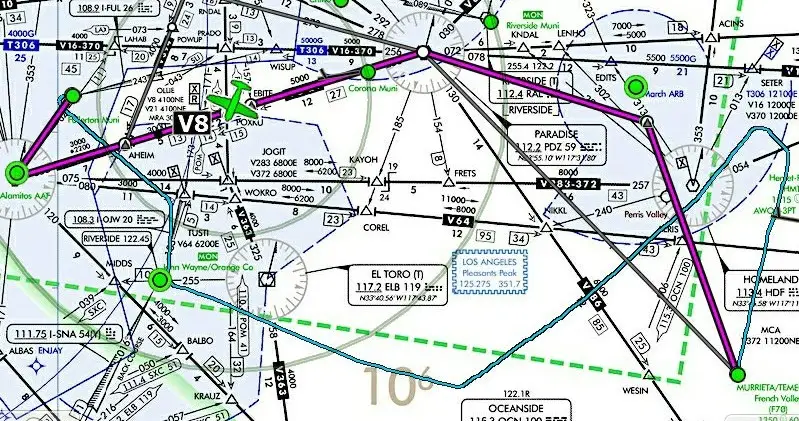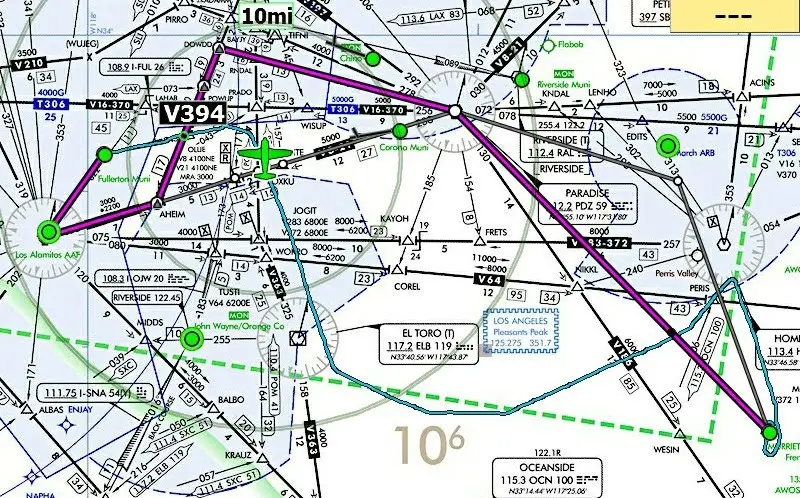IFR Training flights 9 and 10 took place the evenings of April 7th and 9th. The two flights presented some new challenges.
Flight 9 – April 7th
Wednesday we filed IFR flight plans from Fullerton (KFUL) to French Valley (F70) and back. We filed TEC (Tower En Route Control) routes to make things easier for us and ATC.
In the run-up while we were waiting for the engine to warm up to go through the run-up procedures I called up for our clearance.
Me: “Fullerton Ground, Mooney 78878 in the Southeast Runup, ready to copy IFR.”
Ground: “Cleared French Valley, on departure left turn heading one-two-zero, vectors for Seal Beach, Costal Papa one-six, (the TEC Route name) maintain two thousand, expect five thousand one zero minutes after departure, departure frequency one-two-five-point-three five, squawk four-seven-four-one.”
Me: “Cleared French Valley, left turn heading one-two-zero, vectors to Seal Beach, Costal Papa one-six, maintain two thousand, expect five thousand one zero minutes after departure, frequency one-two-five-point-three-five, squawk four-seven-four-one.”
Ground: “Mooney 878, readback correct, advise when ready to taxi.”
Me: “Will advise.”
The Costal Papa 16 (CSTP16) route is Seal Beach VOR (SLI), Victor 8 airway (V8), Paradise VOR (PDZ0, and then JESEX intersection which is the Initial Approach Fix (IAF) for the RNAV RWY 18 approach to F70.
A few minutes later the engine was warm and I went through the run-up where everything checked out. I went through the pre-takeoff checklist and we contacted Ground for taxi clearance and then tower to depart. We departed runway 24, made the left turn to 120, I put on the foggles and called up Departure. That left turn to heading 120 was the last part of the clearance we received on the ground that we would fly.
Departure: “Mooney 78878, climb and maintain four thousand.”
Me: “Climb and maintain four thousand, 878.”
A few minutes later.
Departure: “Mooney 78878, climb and maintain six thousand.”
Me: “Climb and maintain six thousand, 878.”
We were still on a heading of 120 and had flown through the intercept for Victor 8, but ATC had not told us to intercept it so we remained on the current heading.
Departure: “Mooney 78878, turn right heading 180.”
Me: “Right heading 180, 878.”
The rest of the flight was radar vectors and assigned altitudes. After we were handed off to March Approach he gave us vectors to intercept the approach into F70 and then turned us over to the advisory frequency (the common traffic frequency) for French Valley. The approach was clean and at 1,600′, 250′ AGL (Above Ground Level) I pulled off the foggles and there was the runway right in front of us.

We landed and taxied back to the run-up area to get set for the return leg and obtain our IFR clearance. French Valley is an un-towered airport so rather than calling up Ground for clearance we had to make a phone call. The audio panel (PS Engineering PMA450B) is supposed to allow making phone calls right through your headset with your phone connected to the audio panel via Bluetooth. I have used the Bluetooth connection to listen to music and books on long flights but had not tried making or receiving calls.
Before calling up Clearance Delivery I put in a test call to my wife. Sitting in the plane with the engine running my CFII and I could both hear her crystal clear and she could hear me as well. It was great! So, I placed the call to Clearance and picked up our IFR clearance for the flight back. The route is the Ontario Papa 9 (ONTP9) and is Paradise VOR (PDZ), DOWDD intersection, Victor 394 airway (V394), Seal Beach VOR (SLI). We had filed for 4,000′ and Clearance gave us what we filed with the addition of the Homeland VOR (HDF) before Paradise. With the given winds we were departing runway 18 which does not have any Instrument Departure Procedures so the instructions were to depart VFR and contact March Approach in the air.
We took off and after climbing to pattern altitude for noise abatement turned crosswind and then downwind I put the foggles on and called up ATC. We didn’t even make it to the first fix on the route before things changed when March Approach handed us off to SoCal Approach.
Me: “SoCal Approach, Mooney 78878 climbing through 3,400 for 4,000.”
Approach: “Mooney 78878, climb and maintain 6,000.”
Me: “Climb and maintain 6,000, 878.”
About three minutes later.
Approach: “Mooney 78878, climb and maintain 8,000”
Me: “Climb and maintain 8,000, 878.” (Boy was a glad I was in a Mooney and not a Cherokee)
Shortly after that before we even made it to the Homeland VOR ATC gave us a new vector to fly and just like the flight to French Valley the rest of the flight was all radar vectors and assigned altitudes. After a time it looked like we were being vectored to Seal Beach, presumeably for the VOR approach into KFUL so I called up Approach.
Me: “SoCal Approach, Mooney 78878, we would like the RNAV Runway 24 practice approach into Fullerton if possible.”
Approach: “Mooney 878, on request.”
Shortly after that we received a new heading to fly and a lower altitude vectoring us towards the RNAV approach. I was coming downhill, should have pulled power back further than I did, was faster than I really wanted to be, and by the time we intercepted the final approach course I was still high and fast which set me up for a sloppy approach. At 900′ (805′ AGL) I took the foggles off and was happy to see the runway out in front of me.
We talked about the flights afterwards at the hangar. I told him that I felt the approach into French Valley was good, I was ahead of the plane, and it was very stable, however I felt like I was behind the plane on the approach into Fullerton. He said, “Yeah, I was looking at your airspeed and settings and thinking, ‘we’ll see how this works out.'” One of the things I like about this CFII is that he lets me make the mistakes as long as there is no danger and talks about them after. He could have pointed out my power setting and corrected me in the descent, but that would not have been as effective a lesson as me working through it.

Flight 10 – April 9th
I have learned that filing and flying an IFR flight plan is much easier than just going out to shoot approaches and fly hold procedures, at least when the distance between two of the airports is five miles and once you depart one the distance to the Initial Approach Fix is only 9.5 miles. When you are flying longer distances there is plenty of time (between whatever instructions ATC gives you) to look at and review where you are, brief the approach plate, and get ahead of everything.
Our last two training flights were to Palomar and French Valley. This flight we would pick up flight following on the ground to Chino (KCNO) where we would shoot the RNAV RWY 26R approach, go missed and direct back to the Paradise VOR (PDZ) to fly a hold, followed by the VOR/GPS-A approach into KAJO, go missed with a straight out departure to the west to intercept the RNAV RWY 24 approach back into Fullerton for a full stop landing.
We took off and contacted SoCal who asked what our desired altitude was, I responded 3,500 and was told “VFR climb approved, resume own navigation.” We turned direct Paradise VOR (PDZ) and everything was nice and easy for a few more minutes, and then it got busy, really busy. When we were handed off to the next controller I requested the practice approach at Chino and we were assigned 4,500 and given vectors to intercept the final. 4,500 would have worked well had he brought us in at the IAF (Initial Approach Fix) of CAZBY which you cross at or above 4,400′. However he brought us onto the approach at LINDN which you cross at or above 3,000′, the only problem was he had not released us from our altitude restriction until just before intercepting final so we crossed LINDN at 3,680′. I was not managing my speed well and we crossed the FAF (Final Approach Fix) of DEWYE at 2,921′ instead of 2,100′. We continued on down getting more stabilized and I did much better than a few flights ago into Torrance staying on centerline so as not to drift into the approach for the parallel runway. At 1,100′ (the LPV minimum is 1,030′) I added power right as the Tower called “Mooney 78878, begin missed approach.”
Prior to the handoff to KCNO Tower SoCal we had received instructions for the missed as we wouldn’t be flying the charted missed approach. The charted missed takes you to a fix about 15 miles to the Southwest but we wanted to go back to PDZ to fly the hold and approach into Corona (KAJO).
SoCal: “Mooney 78878, how will this approach terminate?”
Me: “We would like to go missed back to Paradise, fly the hold, then the VOR approach to Corona.”
SoCal: “On the go, direct Paradise at or below 3,000 and contact me on this frequency. Contact Chino tower on 119.10.”
Me: “On the go, direct Paradise at or below 3,000, going to tower, 878.”
So, as I added power to go missed I pulled back to slow a little and put the gear up, then began a left turn towards Paradise when the Tower called “Mooney 78878, begin your left turn now, contact SoCal Approach on 135.4.” If things weren’t busy before, they definitely were now. We wanted to go back to Paradise, but the GPS wanted to take us on the published missed approach so while turning toward PDZ and climbing back to 3,000′ I kept a close eye on the turn rate, heading, climb rate, and airspeed while pulling up PDZ on the GPS and hitting “Direct.”
As anticipated (and discussed) the heading we were on led to a parallel entry to the hold over PDZ. ATC assigned us 3,500′ for the hold so we continued the climb and entered the hold. As we came inbound to PDZ we were in line for the approach so naturally the GPS pulled up the approach as the next segment, except we wanted to fly a full lap around the hold. I couldn’t find where to change the GPS back to fly the hold so as we crossed the VOR I began a turn back to the outbound leg, like you would do if you were flying with a VOR instead of GPS. The as I came around to the outbound leg the GPS apparently figured out what I was doing and pulled up the hold again. As we began the turn to the inbound leg SoCal called us up.
Approach: “Mooney 78878, on this lap will you be ready to begin the approach?”
Me: “Affirmative.”
Approach: “Mooney 78878, cleared VOR practice approach, no separation services provided, change to advisory frequency, contact me on the go.” (I had previously told him we were going to go missed followed by the RNAV RWY 24 Approach to KFUL)
Me: “Cleared practice approach, no separation services, going to advisory frequency, talk to you in a few minutes, 878.”
We flew the approach and at 1,700′ (the Circling Approach altitude is 1,660′) I tilted my head back to look out the window and there was the airport right below us, success. I pushed the throttle in, pulled the gear up, turned to depart to the west, and called up SoCal. He asked what we were climbing to and then handed us off to another controller who gave us vectors to intercept the final approach into KFUL.
Fifty minutes after taking off we were back on the ground after flying three approaches and a hold, and I felt like I had gotten a workout. For the next few flights I think I want to do similar exercises, the filing and flying of IFR plans is a good exercise, but the challenge of staying ahead of the plane and radios while flying one procedure after the next really stretches me and improves my skills.


